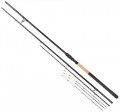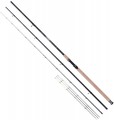Max. casting
The maximum weight of the entire rig (including bait, weights, hooks, etc.) that the rod can handle. This parameter is not recommended to be exceeded: the structure will be subjected to off-design loads and wear out a lot, to the point that the rod can simply break during a normal cast. In addition, the off-design weight of the casting significantly reduces the range and accuracy of the cast, which is critical, in particular, in spinning and match fishing (see "Rod type").
Folded length
The length of the rod when folded. This parameter primarily affects the convenience of transportation: the shorter the folded rod, the easier it is to carry / transport.
Handle material
—
Cork. Handles made of natural cork. This material has many advantages: due to its porosity, it is light and poorly conducts heat (“warms the hand” in the cold), at the same time it does not get wet, and cork handles look quite elegant. The main disadvantage is the relatively high cost, as a result of which cork handles are found mainly in rods of the middle and higher price range (although there are also inexpensive models with such handles).
—
Foam rubber (EVA). Handles made of finely porous ethylene vinyl acetate, a synthetic material. Initially, EVA was used in rods designed for sea fishing — this material is much more resistant to salt water, ultraviolet radiation and other negative influences than cork. However, now it is very common in all types of fishing rods. The advantages of EVA, in addition to the above, are low cost, as well as a variety of designs — unlike cork, this material can be given almost any colour. On the other hand, EVA is significantly heavier, which can be critical for professional anglers who balance their rods to the nearest gram (especially when using ultralight rods). Therefore, such pens are mainly characteristic of inexpensive amateur models.
— Cork / foam rubber. Combined handles, combining both of the above materials in the design. Thus, the advantages of cork and foam rubber are combined, and the disadvantages are partially compensated (for more detai
...ls about the advantages and disadvantages, see above). At the same time, this option is quite rare, because. for a number of reasons, it is still considered more justified to use one specific material.
— Styrofoam. Styrofoam handles — "foamed" plastic (usually based on polystyrene). It consists of individual microscopic cells filled with gas, while the volume of gas can be up to 98% of the volume of the entire material. This determined the main properties of the foam: it is very light, resistant to moisture, in addition, it poorly conducts heat and does not “cool” the hands. Due to the latter, foam handles are well suited, in particular, to winter rods (see "Rod type"). On the other hand, the strength and durability of foam plastic is somewhat lower than that of cork and foam rubber.
— Plastic. Classic plastic is inexpensive, and it is often noticeably stronger than the cork, foam rubber or foam plastic described above. On the other hand, this material is noticeably heavier and has a relatively high thermal conductivity (that is, it can cool hands in cool weather). Thus, plastic handles are mainly used in ultra-compact winter rods. The weight of such tackle is small even taking into account the handle, it does not need an perfect balance, the high strength of the handle is important for technical reasons, and fishing is still supposed to be in warm gloves that reliably isolate hands from the cold.
— Carbon. A variant found in rods made of the same material (see above). The handle in such models is usually a thickening of a special shape on the body. This design allows you to reduce weight and provide maximum responsiveness of the rod, however, it is not cheap. As a result, it is found predominantly among high-end casting models (see "Rod Type"). Like the rods themselves, carbon handles are very resistant to bending, but are sensitive to strong impacts (may crack).
